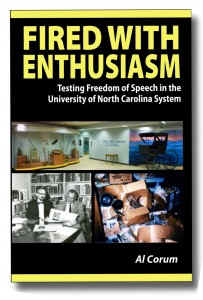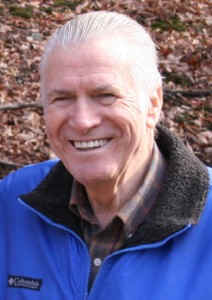‘Fired With Enthusiasm’ – The Story of Leaksville,
NC Native Al Corum and His Nine Year Legal Battle Against Appalachian State
By Paul T. Choate, High Country Press
|
The total cost of the book is $20.00 . It can be ordered directly from the author, Dr. Al Corum. Telephone: (828) 264–2905
|
|
June 27, 2012. On Saturday, June 30, professor emeritus Dr. Al Corum
held a book signing at the Watauga County Public Library for his book “Fired With Enthusiasm,” which chronicles his lengthy legal battle against the Appalachian State University administration and the University of North Carolina system.
In 1984, Corum was demoted from his position as Dean of Learning Resources at ASU after speaking out against plans to break up the Appalachian Collection – an on-campus artifacts museum and research center which was built on many decades of work and donations of artifacts, music, photos and books all related to the Appalachian Region.
“The Appalachian Cultural Center was one of the country’s foremost collections of materials, films, video tapes, recordings, books and artifacts,” said Corum. “[It was] highly recognized and heavily used. It supported several programs at the university.”
According to Corum, during the early 80’s there was a recession going on and many students were dropping out and going back home to work with their families. This led to the development of the Learning Assistance Program. At ASU, the Appalachian Collection was in an area adjacent to the Learning Assistance Program in the library and a “turf war” was going on.
“So, unbeknownst to any of us it was suddenly decided to move the Appalachian Collection without much if any communication – there were snippets once in a while, hints, that sort of thing – to the people that worked in the Appalachian Collection and it was in my area of responsibility.”
Dr. Harvey Durham, ASU’s chief academic officer, sent a memo to Corum on Dec. 12, 1983, stating that the Appalachian Collection would be moved to University Hall – a facility located more than a mile from the main campus – but all the artifacts and research materials would be kept together. Corum was concerned this would be a bad move for the university but agreed to cooperate with the move, happy that the collection would be kept together at least. This, however, did not turn out to be the case. On June 21, 1984, Corum learned it had been decided the collection would be split up during a meeting with Durham. On June 25, 1984, it was announced that the research materials would be moved to University Hall and the artifacts would be located in the library.
According to Corum, the decision to split the Appalachian Collection was due to the fact that Chuck Watkins, of the Appalachian Cultural Museum,
wanted the artifacts but didn’t want anything to do with the research materials. On the other hand, Dr. Carl Ross, of the ASU history department, wanted the research materials but didn’t want anything to do with the artifacts. He added that he believed splitting the items was mainly to appease those two individuals and not in the best interests of the students or faculty.
Over time, controversy arose over what to do with artifacts. Corum said many were eventually given back to the individuals who donated them, given away to area museums or simply lost.
“I don’t really believe anyone knows where [some of the artifacts are] at this point,” said Corum.
Corum was very upset about the decision to split the collection – especially due to the fact that he was previously told the collection would be kept all together. He voiced his concerns to the administration in what he described as a “reasonable way.” On June 27, 1984, he was called to Durham’s office and was accused of gross insubordination. He was given the choice to resign from the university or be demoted. He chose demotion.
On July 11, 1984, Corum wrote a letter to Chancellor John Thomas requesting an appeal meeting to explain his side of the story. He met with Thomas on July 11 and was told that as an “at-will” employee serving at the pleasure of a superior he had no recourse.
Corum was assigned to what he called “monkey work” jobs in the library – a far step down from Dean of Learning Resources – on July 25, 1984.
“There’s a chapter in the book that’s called ‘Homeless in the Library’ and that’s the way I felt,” said Corum. “I felt useless, worthless, but I kept on going … [The administration] stuck me there with a strategy. [They thought], ‘Well this will wear him out. He’ll do something goofy – he’ll threaten somebody, you know, he’ll do something outrageous – and when he does, bingo!’ But I never did it.”
“Fired With Enthusiasm” chronicles Corum’s almost decade-long legal battle against the University of North Carolina system. After many hearings over the course of the next several years, Corum essentially achieved his goal and established the “Corum claim” – a new legal defense for North Carolina citizens under the State constitution. The Corum claim set a new precedent that the State of North Carolina cannot refuse to be sued by claiming sovereign immunity – an exemption that precludes bringing a suit against the sovereign government without the government’s consent.
The trial
Aug. 15, 1984: Corum retained Bruce Kaplan, a local attorney, to represent him in a possible lawsuit.
Sept. 4, 11 and 13, 1984: Corum’s request for a grievance hearing was granted by UNC system president William Friday and the hearing was conducted at ASU by attorney Elizabeth Bunting, legal
assistants to Friday.
“Although this hearing was portrayed as my final recourse, it met virtually none of the legal requirements of an adversarial hearing,” said Corum, adding that it was a “sham.”
Feb. 15, 1985: Bunting wrote a 15-page memorandum to Friday recommending that Corum’s grievance be denied.
Feb. 18, 1985: Corum received a letter from Friday denying his grievance.
“Apparently, he gave scant credence to any testimony that was favorable to me,” said Corum.
July 25, 1985: Kaplan and Corum met in Chapel Hill with the UNC Committee on University Governance in order to appeal Friday’s denial of grievance.
Sept. 10, 1985: Following the advice of Kaplan, Corum retained John W. Gresham, a well-known civil rights attorney in Charlotte.
Sept. 13, 1985: The UNC Board of Governors denied Corum’s petition for relief.
Sept. 14, 1987: Corum made his first courtroom appearance before Judge Charles Lamm in Watauga County Superior Court.
Oct. 12, 1987: Judge Lamm denied the defendant’s motion for summary judgment, allowing the lawsuit to proceed.
Oct. 21, 1988: Special Judge Marvin Gray, Watauga County Superior Court, denied the defendant’s appeal of Judge Lamm’s prior decision against their motion for summary judgment.
Nov. 22, 1988: The defendants appealed Judge Gray’s decision to the North Carolina Court of Appeals.
Sept. 13, 1989: The North Carolina Court of Appeals shifted the burden of proof from Corum to the defendants. The court ruled, however, that Thomas and Durham could only be sued for monetary damages in their individual names, as they were protected in their official capacities by sovereign immunity and qualified immunity.
“This was the low point of the lawsuit,” said Corum.
March 20, 1990: Following an appeal by Corum of the North Carolina Court of Appeals’ ruling, the Court of Appeals ruled that he could bring monetary claims against Thomas and Durham in their official capacities.
Fall 1990: The Al Corum Legal Assistance Fund was established and raised a substantial sum of money.
April 10, 1991: Corum pursued a formal grievance against library administrators Richard Barker, Deborah Carver and Patricia Farthing for alleged salary inequities and violations of his academic freedom. Ultimately, he was unsuccessful in the salary dispute but successful on the issue of academic freedom.
Jan. 31, 1992: The North Carolina Supreme Court ruled, for the first time, that citizens of the state could bring a direct cause of action against state officials, in their official capacities. This ruling created the “Corum claim,” a new legal defense for North Carolina citizens under the State constitution.
June 24, 1992: The North Carolina Supreme Court denied the defendants’ appeal of that court decision.
Sept. 23, 1992: Durham appealed the North Carolina Supreme Court’s decision to the United States Supreme Court.
Nov. 19, 1992: It was reported that the United States Supreme Court had denied Durham’s appeal and rejected his arguments that he was entitled to qualified immunity. The case was sent back to Watauga County Superior Court.
April 26, 1993: Jury selection for the trial was conducted in Watauga County Superior Court.
April 27, 1993: Corum’s lawsuit was settled a few minutes before the trial was supposed to begin after almost nine years of litigation. A Stipulation of Dismissal and Settlement formalized the legal agreement.
Aftermath
Corum said that the nine-year ordeal was not all that difficult on him most of the time because he had been through difficult times many times before in his life, but said that it was very difficult on his wife and his family at times.
On July 1, 1993, Corum was officially transferred from the library to the Department of Leadership and Educational Studies. At that time he was permitted to take until the beginning of the 1994-95 academic year to prepare for his new responsibilities. He assumed his academic duties in the fall of 1994.
He officially retired in May 1997 as professor emeritus. He described his last three years at ASU as the best three years he ever spent working there.
“It was a convoluted case that started off as just a minor disagreement and escalated into a dispute, and then blossomed into a lawsuit,” said Corum, adding that he could have simply quit and found work elsewhere, “But I like Appalachian. I went to school here and I have a deep love for Appalachian.”
About the author:
I was born in Leaksville on September 14, 1931, the middle son of Robert and Georgia Corum. After attending Burton Grove Elementary
School, I graduated from Leaksville High School in 1949. While in high school, I played baseball and basketball with guys such as Fred
Smith, Billy Fulton, Richard Carter, Preston Holt, Kent Moseley and Harold Matthews, as well as many others. Little did I know that my
days spent "navigating the waters" of the Leaksville "Y" would help me through many rough spots later on.
Some of the adults who influenced my life were the following: 1) my mom, who struggled, mostly against the tide, to teach me the
importance of education, 2) Coach Raymond Rhodes, who taught us that intelligent strategy often worked better than raw aggressiveness, 3)
Mr. Harry Davis, my next–door neighbor, who demonstrated the role of a true elected official and encouraged me in athletics, 4) Miss Susan
Abernathy, my fourth grade teacher, who fed my hunger and soothed my anger when both were gnawing at me, and 5) "Uncle William" Hampton, an
elderly black neighbor, who told me riveting stories about his life and taught me how to trap and skin rabbits.
All things considered, I feel fortunate to have grown up in Leaksville.
It is a rare privilege, after all these
years, to reconnect with my hometown through
the "memory machine" known as leaksville.com.
---Dr. Al Corum

